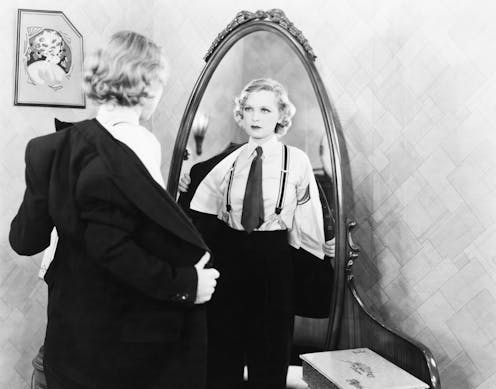
HSBC has recently introduced what it calls a “more casual” uniform for its branch staff, including jumpsuits and jeans, “menopause-friendly” clothing, as well as “ethnic wear”. The uniforms aim to make staff immediately visible to customers and also signal a clear corporate message of a friendly, approachable high street bank.
Last year, Virgin Airlines announced that staff could wear any version they wish of its Vivienne Westwood-designed staff uniforms, giving space for personal expression of gender identity.
Such changes hint at the difficulties involved in working out what to wear at work, especially for women working in offices or in customer – and client-facing roles. Without a uniform – be that employer-designed or a female version of the traditional work suit – women have often had to forge their own identity at work.
This is because, like it or not, work clothes are important. They reflect the identity of both employee and employer, as well as status. Clothes communicate key information and influence how others perceive the wearer.
In a corporate environment, clothing also reflects the identity of the organisation. Many businesses still see what employees wear as an important indicator of their brand and it also affects perceptions of employees on an individual basis. This is the case with uniforms, as well as when women wear their own clothes to work.
Our research on workwear for women in banking in the 1970s shows how Barclays Bank used uniforms as a branding tool, but also indicates the role gender has played in women’s work clothes over the years. This work was possible thanks to access provided by Barclays Group archives.
We looked at the introduction of a new role – the personal banker – by Barclays in the 1970s. This was an entry-level position, based primarily on the shop floor, engaging with customers and being more approachable and available than traditional clerks or bank managers. In the early days, the position was mostly held by women and there was a corresponding uniform (see image) of a blue two-piece skirt suit with a white blouse.
Female personal bankers, on the whole, seemed to enjoy wearing this uniform. Our research shows they saw it as an equivalent to the male business suit, that gave them a sense of legitimacy and status that they did not have in the traditionally male banking world.
It’s telling then that the small number of male workers that were personal bankers at Barclays in the 1970s did not have uniforms. Those in charge at the time preferred “to confine the wearing of uniforms to the ladies”, according to a document sent between two senior staff members on September 3 1979 that we found in the archive.
To this day, dark-coloured, “sensible” work suits convey the classic image of a banker in sober, serious, professional attire. This “uniform” is a clear signal of authority and status in the workplace.
Suits have also been adopted by women, of course. But they still tend to have more choices to make than men, even if they wear a suit to work: trousers or skirt, length of skirt, fabric colour, boots or shoes, heel height, neckline, accessories – the list goes on. And the options they choose can affect how they are seen by bosses, colleagues, clients and customers.
Indeed, documents from Barclay’s archives showed that managers felt women were able to provide the personal, caring and relationship-based approach in branches that it was seeking at the time. And the uniforms were an attempt to support the bank’s thinking around this kind of branding. One internal marketing report from 1979 said:
We believe that uniforms create an attitude of mind on behalf of those that wear them … and an improved perception of the bank on behalf of our customers. They strongly reinforce the idea that we are doing something different to what we have done in the past.
Post-lockdown workwear
Various research has found that perceptions of women in the workplace are still influenced by the way they dress, often in a way that perceptions of men are not. This research has found that clothing deemed to be “unsuitable” by colleagues or customers can result in women being viewed as less competent or of lower status than men in the same working environment.
One of the studies above concludes:
Clothing is enough of a cue for people to make significant character judgements. An important implication of our results is that not following clothing rules can have a negative impact on how people perceive women.
Of course, what many people wear to work has become progressively more relaxed since the 1970s. Pre-COVID, many firms had “dress-down” Fridays or “business casual” dress codes. But the adoption of relaxed clothing really ramped up when many people were working at home during the COVID lockdowns.
This has continued since, with suit sales falling in recent years – even Goldman Sachs relaxed its dress code for some staff. But recent reports suggest that UK women working remotely during the global pandemic were still being asked by companies to look more attractive to win new business.
So, while more relaxed clothing and even gender-neutral uniforms are being introduced in offices, banks or on planes, it seems that women still have some way to go in terms of perceptions of their work being based on their appearance. A continued shift in attitudes, not just corporate clothing, is still needed.
The authors do not work for, consult, own shares in or receive funding from any company or organisation that would benefit from this article, and have disclosed no relevant affiliations beyond their academic appointment.
This article was originally published on The Conversation. Read the original article.







